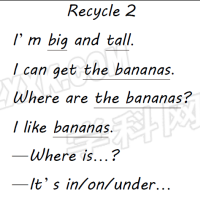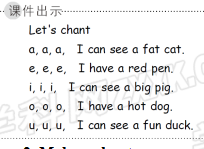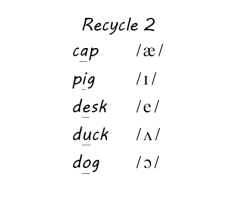|
三年级英语下册—《Recycle》Recycle 2
Page 66 & Page 67
▶教学内容与目标
▶教学重点 1. 能够听懂、会说、认读句型“I’m big and tall/short.” “I can…” “I like…”,并能够在真实或模拟的情景中正确使用所学句型来进行交流。 2. 复习表示水果、方位的单词,做到能听懂、会说、会认读。 ▶教学难点 能够根据具体的情景选择相应的句子进行恰当的交流。 ▶教学准备 相关动物的头饰、用来评价奖励的小贴画、PPT课件、课文录音、视频等。 ▶教学过程 Step 1: Warm-up & Revision1.Greetings.[来源:学_科_网Z_X_X_K] 2. Sing a song—Finger Fruit Song. (出示课件) 3.Revision. The teacher takes some wo T: Do you like apples? Ss: Yes, I do./No, I don’t. Students make dialogues and act them out. Step 2: Presentation1.Lead-in. T: Look at the pictures on page 66. (出示课件) The animals will have a party tomorrow, so today they prepare something for the party. Where are they? Ss: They are in the orchard. T: How many animals can you see? Ss: Four. T: Who are they? Ss: An elephant, a bird, a duck and a monkey. T: What are they doing? Ss: They are getting some fruit. 2. Watch and answer. (1) Let students watch the video for the first time, and get the main idea of the dialogue. (课件出示:教材Read aloud的视频) Show Picture 1.
T: Now answer these questions. ①Who can get the grapes, why? ②Who can get the bananas, why? ③Who can get the strawberries, why? S1: The bird can get the grapes, because it can fly. S2: The elephant can get the bananas, because it’s big and tall. S3: The duck can get the strawberries, because it’s short. T: You’re great! Show Picture 2, 3 and 4. (课件出示:教材P66 Read aloud的第二、 T: The animals finish their work. Now the monkey is counting the number of the fruit. Let’s see wha ①How many bananas do they get? ②How many grapes do they get? ③Where are the bananas? Who likes bananas? S1: They get 13 bananas. S2: They get 20 grapes. S3: The elephant gets the bananas. The monkey and the elephant like bananas. T: You all do a good job. Excellent! (Encourage students to answer the ques
(2)Students watch the video for the second time, then read after it. Pay attention to the pronunciation and the intonation. 3. Ask students to read the dialogue freely and as T: I will give you five minutes to read the dialogue freely. Ss: (read the dialogue freely) T: Now I need some students to read the dialogue in roles. Who wants to be the elephant?… Ss: (read the dialogue in roles) In the end, the teacher gives the best group stickers as the prize. Step 3: Practice1. Act out the story. The teacher asks some groups to go to the front of the classroom. And students choose their animal headwears to act out the story. The teacher should pay more attention to the students poor in English and encourage them to act. 2. Wha We should share things with our friends. Step 4: Consolidation & ExtensionListen and draw. 1. The teacher shows the picture, and discusses the content with students. (课件出示:教材P67 Listen and draw的图片) T: What can you see in this picture? Ss: I can see… (Answer the question freely.) 2. Students listen to the recording, and draw something on the picture. T: Let’s draw something on this picture. Listen and draw. (播放课件) Ss: (Listen to the recording and draw.)[来源:Z。xx。k.Com] T: What do you draw? Where are they? Show me your pictures. In the end, the teacher shows the answer on the PPT. (课件出示:答案及听力材料) T: How many footprints do you see? Ss: (Count the footprints.) 19 footprints.
▶板书设计
▶教学反思 1.总体来说,整个教学设计基本上实现了课程教学目标。[来源:Z+xx+k.Com] 2.在如何提高活动的有效性、把握好“放”的尺度方面,还需要进一步探索。 3.本节课目的是为了操练和巩固语言知识。但是因为是复习课,有些学生兴致不高,离预期的教学效果还有一定差距。因此教师还需考虑活动的趣味性,要努力让全体学生在课堂上愉快地学习英语!
The second period(第二课时) Page 68 & Page 69
▶教学内容与目标
▶教学重点[来源:Z*xx*k.Com] 1.能够听懂、会说本册书的重点词汇。 2.能够在真实或模拟的情景中听懂、会说本册书中关于询问国籍、位置、数量等内容的句型。 ▶教学难点 能够在真实或模拟的情景中选择1~6单元中的重点 ▶教学准备 PPT课件、课文录音、视频、卡片等。 ▶教学过程 Step 1: Warm-up & Revision1.Greetings. 2.Enjoy the song—Sing a song of A B C. (出示课件) Step 2: PresentationLook and write. (课件出示:教材P69 Look and write的练习) T: Boys and girls, please look at the pictures and guess what they are. Ss: … T: Now please write down the words. After students finish their work, the teacher shows the answers on the PPT and check the answers together.
T: (Point to the letter “a” in the word “cap”.) How to pronounce this letter “a”? Ss: /æ/. T: (Write down “/æ/” on the blackboard.) Yes, the letter “a” pronounces /æ/ here. Give the examples: fat, cat, hat, dad, man, apple, map… T: (Point to the letter “i” in the word “pig”.) How to pronounce this letter “i”? Ss: /I/. T: (Write down “/I/” on the blackboard.) Yes, the letter “i” pronounces /I/ here. Give the examples: big, pig, six, is, it, sister, thin, in…[来源:学科网ZXXK] T: (Point to the letter “e” in the word “desk”.) How to pronounce this letter “e”? Ss: /e/. T: (Write down “/e/” on the blackboard.) Yes, the letter “e” pronounces /e/ here. Give the examples: desk, red, pen, twenty… T: (Point to the letter “u” in the word “duck”.) How to pronounce this letter “u”? Ss: /ʌ/. T: (Write down “/ʌ/” on the blackboard.) Yes, the letter “u” pronounces /ʌ/ here. Give the examples: cup, bus, duck, fun, under… T: (Point to the letter “o” in the word “dog”.) How to pronounce this letter “o”? Ss: /ɔ/. T: (Write down “/ɔ/” on the blackboard.) Yes, the letter “o” pronounces /ɔ/ here. Give the examples: hot, dog, long… Step 3: Practice[来源:学科网ZXXK]1.Let’s chant. T: Look at this chant. Listen to the recording first. (播放课件) Then read after it.
2. Make a chant. T: I hope you can find other words containing the letters “a, e, i, o, u” from your English books. Then make a new chant with the new words you find from your English books, and I will check next class. Do you understand? Ss: Yes. 3. Sing a song—Short vowel song. T: Turn to page 69 and read the song, then listen to the song. (播放课件) Students learn the song line by line. T: Let’s sing it together. Step 4: Consolidation & ExtensionGo up the ladders. Go down the snakes. T: Now let’s pl Ss: Yes, we can. T: Go up the ladders. Go down the snakes. The student who finishes first is the winner. Look at this picture. What can you see? (Point to the picture of Mike.) Ss: I can see Mike with T: Yes, Mike is from Canada. What about this picture? (Point to the picture of pears.) Ss: I can see fifteen pears. T: Good. I like pears. What about you? Ss: I like pears, too. T: Very good! Boys and girls, you can say different things about the pictures. Now play in groups. Have a good time! Encourage students to talk about the pictures by using different sentences. Then let them show their work in the class. [来源:学§科§网Z§X§X§K]
▶板书设计
▶教学反思 1.本课主要以复习为主,活动设计很丰富。 2.活动设计循序渐进,一步步引导学生,让学生自己找规律,培养学生的自主学习能力。 3.充分利用网络资源来活跃课堂气氛,激发学生的学习兴趣。
|



























